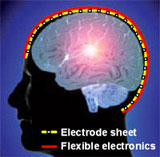Target Application: Wireless Brain-Machine Interface (BMI)

This team endeavors to create a wearable brain-machine interface (BMI) which senses electrical potentials associated with brain activity.
Such BMI sensor systems can be used for diagnosing brain disorders, and pioneering research indicates they may allow humans to control machinery by thought alone. BMI sensor systems require a large number of channels (256 or more) collected from an area covering much of the head.
The proposed wearable BMI will be far simplified — a flexible, form-fitting cap with integrated sensors, detection and digitization electronics, and wireless communication capability.
Read more in Circuits. |
|

Project Goals
Our team seeks to develop the knowledge necessary for high-speed manufacturing of fast, power efficient, high-density circuits printed on flexible substrates. Motivated by the tremendous potential of flexible and thin-film printed electronics systems to benefit national security and the U.S. economy, we seek to overcome tremendous challenges. These include:
Synthesis of high performance, flexible and printable electronic materials sets;
Creation of a high speed, roll-to-roll (R2R) manufacturing process that can produce sophisticated electronic circuits;
Demonstration of manufacturing efficacy by construction of a multi-functional, hybrid electronic system.
This MURI team’s ten investigators will develop electronically functional inks and a high-speed R2R printing process to produce flexible circuits with integration densities of 1000 transistors/cm2, which will represent a true quantum leap in flexible electronics manufacturing capability.
To demonstrate the materials and manufacturing process, the team will design and construct a wearable, multi-functional distributed sensor network for brain-machine interfacing (BMI). The BMI device will consist of hundreds of sensor elements integrated into a form fitting cap to detect brain waves and the intent of the human subject.
The new materials sets, the manufacturing process, and the BMI sensor system will be the principal deliverables of this project, in addition to the training of 10 graduate students and postdocs in flexible printed electronics technology.
Partner Universities in this Multi-University Research Initiative (MURI):

|
|
Project Updates
September 26, 2012 — Development update, Northwestern University, Evanston, Illinois
March 21, 2012 — Development update, University of Texas, Austin
September 23, 2011 — Kickoff meeting, Washington, DC
Recent Publications
"Delayed Ignition of Autocatalytic Combustion Precursors: Novel Low-Temperature Nanomaterial Binder Approach to Electronically Functional Oxide Films," J. Amer. Chem. Soc. 2012, 134, 11583–11593. Kim, M-G.; Kim, H.S.; Hennek, J.; Kanatzidis, M.G.; Facchetti, A.; Marks, T.J.
"Exploratory Combustion Synthesis: Amorphous Indium-Yttrium-Oxide as a Semiconductor for Oxide Thin-Film Transistors," J. Amer. Chem. Soc. 2012, 134, 9593–9596. Hennek, J.W.; Kim, M.-G.; Kanatzidis, M.G.; Facchetti, A.; Marks, T.J.
"Solution-Processed Dual-Gate Polymer Field-Effect Transistors for Display Applications,"
Tae-Jun Ha*, Prashant Sonar, and Ananth Dodabalapur*, IEEE/OSA J. Display Technology.
"Heterogeneous Segmental Dynamics during Creep and Constant Strain Rate Deformations of Rod-Containing Polymer
Nanocomposites," Macromolecules, 2012. Gregory N. Toepperwein, Kenneth S. Schweizer, Robert A. Riggleman, and Juan J. de Pablo.
"Nonequilibrium Simulations of Lamellae Forming Block Copolymers Under Steady Shear: A Comparison of Dissipative Particle Dynamics and Brownian Dynamics,"Macromolecules, 2012. Brandon L. Peters, Abelardo Ramírez-Hernández, Darin Q. Pike, Marcus Müller, and Juan J. de Pablo.
|


